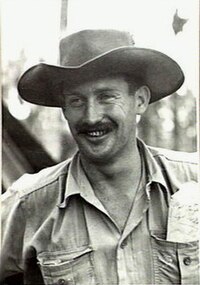Leslie Douglas Jackson | |
|---|---|
 Squadron Leader Jackson commanding No. 75 Squadron in New Guinea, September 1942 | |
| Born | 24 February 1917 Brisbane, Queensland |
| Died | 17 February 1980 (aged 62) Southport, Queensland |
| Allegiance | Australia |
| Service/branch | Royal Australian Air Force |
| Service years | 1937–1946 |
| Rank | Wing Commander |
| Unit |
|
| Commands |
|
| Battles / wars | |
| Awards | Distinguished Flying Cross & Bar |
| Relations | "Old John" Jackson (brother) |
| Other work | Businessman |
Leslie Douglas (Les) Jackson, DFC & Bar (24 February 1917 – 17 February 1980) was an Australian fighter ace of World War II, credited with five aerial victories. Born in Brisbane, he was a businessman when he joined the Royal Australian Air Force (RAAF) Reserve in 1937. Called up for active duty shortly after the outbreak of war in September 1939, he served with No. 23 Squadron in Australia before posting to the South West Pacific theatre with No. 21 Squadron in Singapore. In March 1942 he joined No. 75 Squadron in Port Moresby, New Guinea, flying P-40 Kittyhawks under the command of his eldest brother, John. During the ensuing Battle of Port Moresby, Les shot down four Japanese aircraft.
Jackson took over command of No. 75 Squadron after his brother was killed in action on 28 April 1942, leading it in the Battle of Milne Bay later that year. Credited with a fifth aerial victory, he became the RAAF's first ace in the New Guinea campaign, and was awarded the Distinguished Flying Cross (DFC). By 1944, Jackson was wing leader of No. 78 (Fighter) Wing in Western New Guinea, gaining promotion to wing commander in September that year. Awarded a bar to his DFC in March 1945, he served as chief flying instructor at No. 8 Operational Training Unit in Australia, and saw out the war as commander of Air Defence Headquarters, Madang. After leaving the RAAF in 1946, Jackson returned to the business world, running two garages. He died in Southport, Queensland, in 1980.